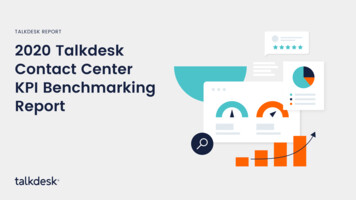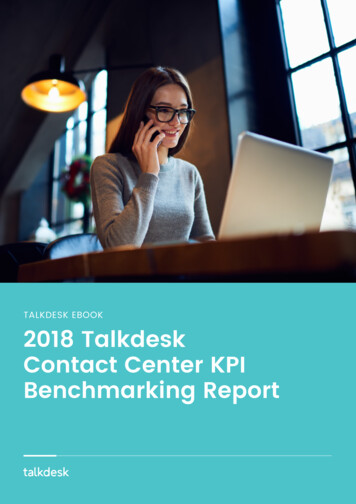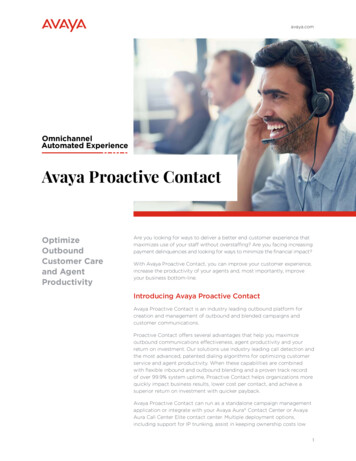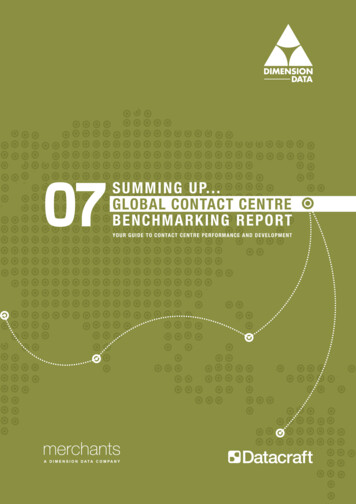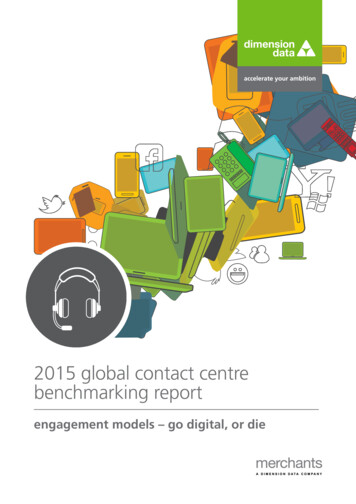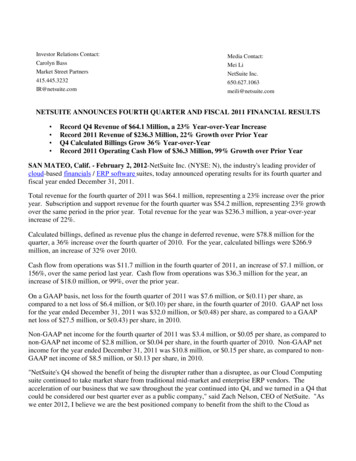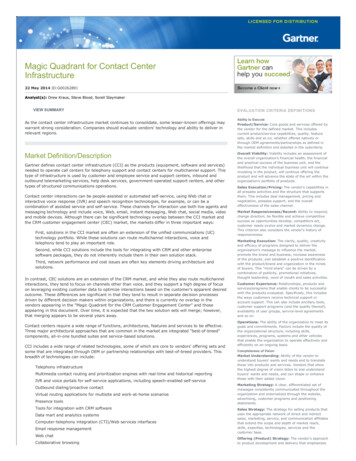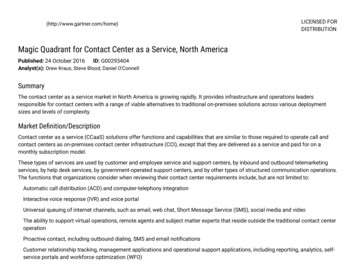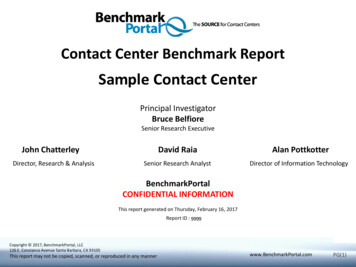
Transcription
BENCHMARKINGYOUR CONTACTCENTERBy: Natalie Romano, Managing Principal,Strategic Consulting, Avaya Professional Services
To meet changing customerrequirements and growingexpectations, contact centersmust be proactive and continuouslyimprove their operational performance.However, shrinking budgets andother scarce resources make thistask difficult.One of the arrows in the contact centerquiver is benchmarking: the process ofimproving performance by identifying,understanding, and adapting leadingpractices found both within andoutside the organization. In the currentenvironment of conflicting pressures—cost containment and growingcustomer demands—benchmarking canbe the right tool for this difficult job.Initial ConsiderationsThere are two types ofbenchmarking, each of whichserves a different purpose.Performance, or quantitative,benchmarks are used to comparethe results achieved with a givenproduct or service against thoseoffered by other similar companies.The outcome generally provides acomparative ranking and is often usedto highlight performance areas thatneed further study and improvement.The companies selected forquantitative comparison are usuallyfrom the same sector, by eitherindustry or functional group.Process, or qualitative, benchmarksare used to improve specific processesand operations within the business.Well-managed companies don’t usebenchmarks simply to set targets.Instead, they look beyond thequantitative data to understand theprocesses, tools, and methods thatleading companies use to achievesuperior results.For best results, both performanceand process benchmarking shouldbe used together. Think of them ascomplements rather than alternatives.Deciding Against Whomto BenchmarkThe standard of comparisoncan be external, internal, orpreferably both.There are three sources ofexternal measures:1. Benchmarking against pools orsurveys of other companies.2. Benchmarking againstindividual companies.3. Benchmarking againstcustomers (expectations).For the most part, benchmarkingagainst a pool or survey is the simplestway to conduct an external quantitativestudy. This type of benchmarkingis usually sponsored by an industryor professional organization.Representatives of participatingcompanies complete a survey orquestionnaire and receive reports inreturn, perhaps for a fee, showing therelative performance rankings amongthe companies.Companies seeking qualitativeanalyses will work with one companyor a small group of other companies.Every company has unique processes,but some core processes andoperations are common acrossindustries. For example, almost allcompanies have procurement andaccounts payable processes, andleading practices from one industrycan be employed in others.The third approach, benchmarkingagainst your customers’ expectations,helps uncover disconnects in customersatisfaction. You may think yourcontact center is doing well, butbenchmarking can point out frequentcustomer complaints that you’ve beenoverlooking. Customer benchmarking isespecially important for companies thatprovide services to other businessesand in industries where the costof losing a customer is substantial.Chapter 8 // Putting It Together // 2
Six CoreTechniques forBenchmarkingBenchmarking alone doesn’t improveperformance. You have to take actionbased on the benchmarking results.01Decide Whatto lect Data& AnalyzeStrategizeACTION:ImplementNew StrategyMonitorPerformance
Examples include third-party logisticsproviders, contract manufacturers, andshippers that supply product to retailstores or distributors.Internal benchmarking involves lookinginside your organization, rather thanat other companies or industries, toidentify leading practices that can beleveraged across the organization.Any company with multiple businessunits, divisions, or locations can useinternal benchmarking. Even smallcompanies with a single location caninternally benchmark by comparinghow individual employees approachsimilar tasks.One advantage of internal benchmarkingis that it’s easier and less expensiveto implement. It also creates a cultureof continuous improvement, in partby spurring internal competition.However, a potential drawback ofinternal benchmarking is that it maynot provide comparison against trueleading practice standards. Usingmultiple sources—both internal andexternal—to measure performancewill enable you to better understandyour organization’s processes, yourcustomers’ opinions, and how wellyou stack up against competitors.Barriers to Effective BenchmarkingA major stumbling block for companiesas they start to benchmark isobtaining reliable statistics on theirown contact center operations. Oftenthe information must be painstakinglyassembled from disparate systems.Even when the statistics can begathered, it may be difficult to alignthem with industrywide measures toperform apples-to-apples comparisons.Companies often make the mistakeof measuring for the sake ofmeasurement, and in the processthey calibrate everything. As manyas 150 metrics can be measured in acontact center. But too many metricscan make it difficult, if not impossible,to develop meaningful conclusionsfrom the mountain of data youA major stumblingblock for companiesas they start tobenchmark isobtaining reliablestatistics on theirown contact centeroperations.collect. As an alternative, consideridentifying 10 key performanceindicators. Tie those indicators backto your strategy, operations, people,processes, and technology to improvecompetitiveness, customer service,and efficiency.Another common pitfall is when theperformance indicator itself becomesthe goal. If the company you’rebenchmarking against achieves a lowrate of customer-abandoned calls orhigh customer satisfaction, that flashymeasure may become the end goal,regardless of what dysfunctional orinefficient processes may underpin it.In contrast, companies that benchmarksuccessfully will try to find out whyprocesses work well rather than justtheir end results. For example, if acontact center is handling somethingpotentially complicated like insuranceclaims, it doesn’t make sense to set atarget talk time of less than a minutefor agent interactions. So always lookat the qualitative context, not just thequantitative results, in order to choosethe most meaningful benchmarks.Making good use of benchmarkingresults is the next challenge.Appropriate, insightful interpretationof the results is essential to identifyingwhich shortcomings should be the onesyou invest time and energy into fixing.Chapter 8 // Putting It Together // 4
Figure 8.2: The Changing Importance of ratingFirstcallresolutionCostper ationCalltransferrateMuch more importantA little more importantNo changeA little less importantMuch less importantDon’t know/NASource: Contact Center Benchmarking Report 2012, Dimension Data.Once you’ve identified the opportunities,the real work of putting them intoaction begins. This can’t be emphasizedenough: Benchmarking alone doesn’timprove performance. You have to takeaction based on the benchmarkingresults. It’s critical to understand whereinefficiencies and performance gaps areoccurring within your organization andthen identify and implement changesto address the poor performance. Andalways keep unintended consequencesin mind—an attempt to improveperformance in one area can dragdown other areas.Implementing a benchmarking programand acting on its results will helpequip your organization to improvecontinuously. Focus on developing astrategy to implement leading practicesand on making the process changesneeded to drive improved performance.New Metrics for CEMEven with the changes in today’smarketplace, the traditional contactcenter metrics of customer satisfactionscores, first call resolution, andservice analytics can still act as yourmeasurement foundation. Customer satisfaction scorescontinue to reveal a lot about howyour customers perceive yourorganization and whether they’dlike to continue doing businesswith you. Avaya’s ConsumerPreference Study found that agreat customer experience notonly helps maintain your currentbusiness, but also motivates70 percent of customers tospend more money (Avaya, 2011). Both first call resolution andservice attempt analytics revealthe efficiency of your contactcenter and the impact on customerexperience. Identifying thefrequency and duration of yourcustomer calls can help you targetareas for quality improvements.We found that 36 percent ofcustomers will consider defectingafter only two to three attempts
to resolve their issue! Staying ontop of these traditional metricswill allow you to make better,more customer-centric decisions.Because of how communications hasevolved, there are now a number ofnew channels you must monitor forcustomer experience effectiveness: Measuring your social mediainteractions has become acritical priority due to theprevalence of social media intoday’s marketplace. Listeningto the market and engagingin the right conversationscan help you spot issues andopportunities as they arise,perhaps even before anyonecontacts your organization.Avaya has found that 50 percentof customers are more likely tobuy if they’re already engagedwith an organization throughsocial media. The integration of social mediainto the contact center has onlyjust started. The metrics are stillbeing defined. However, metricsthat companies are beginningto monitor include mentions ofa company and its products orservices on social networkingsites; responses to blogs andTwitter posts regarding thecompany; and use of tweets tocommunicate directly with thecontact center.The Power of ApplyingBenchmarking ResultsAfter it added 14,000 customersvirtually overnight, a southernCalifornia waste managementcompany’s contact center beganexperiencing significantly highercall volume. The company believedit could use existing call centertechnology more effectively andimprove several key performanceindicators such as call abandonrate and the average speed toanswer calls.The company conducted abenchmarking and performanceaudit on its existing contact center.The resulting report addressedeffective management practices,operational and technology changesfocused on customer satisfaction andoperational efficiency, and industryleading performance objectivesand results for comparable serviceindustry contact centers. Afterimplementing the recommendedchanges, the waste managementcompany achieved significantimprovements, including these: The average speed to answercalls was cut by nine seconds. Customer satisfaction ratingsimproved by 14 percent. Call abandon rates declined by16 percent. Speech analytics introduces theability to dissect the contentof your recorded calls andmeetings. These tools providecompanies with deeper insightson the quality of their pastinteractions in order to improveservice effectiveness for greatercustomer satisfaction.Natalie Romano is Managing Principal, Strategic Consulting, Avaya Professional Services,and has more than 18 years of experience working with contact center organizations. She isa recognized leader in the areas of contact center and customer experience and has a proventrack record as a strategist, leader, and advisor in developing world-class contact centers.Chapter 8 // Putting It Together // 6
Source: Contact Center Benchmarking Report 2012, Dimension Data. Customer satisfaction rating First call resolution Cost per call Call abandonment rate Speed to answer Average call duration Call transfer rate Percentage 80 100 60 40 20 0 59% 20% 18% 1% 43% 25% 19% 6% 36% 24% 6% 28% 30% 22% 3% 2% 5% 41% 33% 18% 37% 23% 24% 4% 3% 35% 11% 16% 23% 2% 5% 44% 10% Much more
